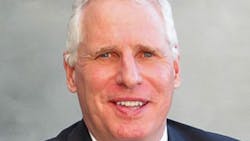I have always loved tall buildings. It may have started when I was a lad in New Jersey looking at the Manhattan skyline, or when my father took my brothers and I to the World Trade Center construction site when it wasn’t much more than a gigantic hole in Manhattan’s granite womb. Later in life, I loved meeting Howard Roark, the architect in Ayn Rand’s The Fountainhead, and learning about his aspirations to crack the sky with unconventional office towers.
I still love looking at the designs of innovative new buildings, but as a business journalist perusing indicators of the construction market’s health, I now see them not only as the fulfillment of the dreams of an architect like Roark, but as signs of economic growth that provide sales opportunities for readers of this magazine.
Whether it’s a high-profile downtown office tower like New York’s Freedom Tower or a more modest building in a suburban office park, office construction provides big dollars for distributors, manufacturers, reps and contractors. According to EW’s Market Planning Guide, new office construction accounts for an estimated 9% of all electrical products sold through distributors of electrical supplies for a total of $9.6 billion in estimated sales potential and the sale of electrical maintenance supplies and office retrofits account for an additional 9.4% in sales and another $10 billion in potential sales. The news going forward is good on the office front, according to AIA’s Consensus Forecast, which says office construction will grow 13.3% this year.
If you also have a fascination with office towers, check out the Council on Tall Buildings and Urban Habitat (www.ctbuh.org), a Chicago-based nonprofit group that collects data on new office construction and provides popular listings of the world’s tallest buildings. In the chart below, you will see the 10 tallest office towers or other commercial buildings now under construction in the United States. While these projects are changing the skylines of U.S. cities, they don’t make the CTBUH ranking of the 10 tallest buildings now under construction in the world, which currently includes four buildings in China, two in Dubai and one in Moscow — all over 1,000 feet tall.
World-class office projects don’t always provide the most profitable business because so many people want a piece of the action. But they may be the construction world’s most visible indicator of the sales possibilities out there in the market — and the power of the human mind to create and construct beautiful buildings. I think Howard Roark might agree.
About the Author
Jim Lucy
Editor-in-Chief of Electrical Wholesaling and Electrical Marketing
Jim Lucy has been wandering through the electrical market for more than 40 years, most of the time as an editor for Electrical Wholesaling and Electrical Marketing newsletter, and as a contributing writer for EC&M magazine During that time he and the editorial team for the publications have won numerous national awards for their coverage of the electrical business. He showed an early interest in electricity, when as a youth he had an idea for a hot dog cooker. Unfortunately, the first crude prototype malfunctioned and the arc nearly blew him out of his parents' basement.
Before becoming an editor for Electrical Wholesaling and Electrical Marketing, he earned a BA degree in journalism and a MA in communications from Glassboro State College, Glassboro, NJ., which is formerly best known as the site of the 1967 summit meeting between President Lyndon Johnson and Russian Premier Aleksei Nikolayevich Kosygin, and now best known as the New Jersey state college that changed its name in 1992 to Rowan University because of a generous $100 million donation by N.J. zillionaire industrialist Henry Rowan. Jim is a Brooklyn-born Jersey Guy happily transplanted with his wife and three sons in the fertile plains of Kansas for the past 30 years.

